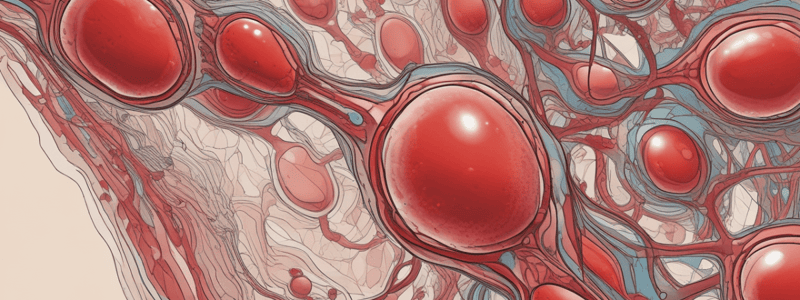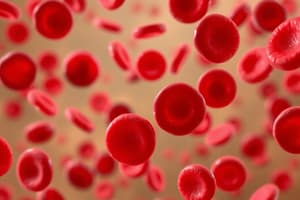Podcast
Questions and Answers
What is the primary function of erythropoietin in the body?
What is the primary function of erythropoietin in the body?
- To conjugate bilirubin in the liver
- To stimulate bone marrow RBC production (correct)
- To destroy RBCs
- To regulate iron recycling
In babies, jaundice occurs due to liver maturity.
In babies, jaundice occurs due to liver maturity.
False (B)
What is the purpose of phlebotomy in treating polycythemia?
What is the purpose of phlebotomy in treating polycythemia?
To decrease hematocrit levels
RBCs are typically destroyed after _______ days.
RBCs are typically destroyed after _______ days.
Match the following conditions with their effects on RBC production:
Match the following conditions with their effects on RBC production:
What is a common cause of secondary polycythemia in adults?
What is a common cause of secondary polycythemia in adults?
What triggers the release of erythropoietin in response to low oxygen levels?
What triggers the release of erythropoietin in response to low oxygen levels?
Artificial erythropoietin can cause hypotension.
Artificial erythropoietin can cause hypotension.
What happens to the iron from heme during RBC destruction?
What happens to the iron from heme during RBC destruction?
Newborn babies may experience polycythemia due to ____________________ levels of oxygenation.
Newborn babies may experience polycythemia due to ____________________ levels of oxygenation.
What is a common manifestation of hyperviscosity in polycythemia?
What is a common manifestation of hyperviscosity in polycythemia?
Match the following conditions with their relation to erythropoiesis:
Match the following conditions with their relation to erythropoiesis:
Secondary polycythemia can be caused by obstructive sleep apnea.
Secondary polycythemia can be caused by obstructive sleep apnea.
What is the goal of phlebotomy in treating polycythemia?
What is the goal of phlebotomy in treating polycythemia?
Which of the following is NOT a cause of polycythemia?
Which of the following is NOT a cause of polycythemia?
Erythropoietin is produced by the liver.
Erythropoietin is produced by the liver.
What happens to the heme during RBC destruction?
What happens to the heme during RBC destruction?
Erythropoietin is released in response to ______________________ oxygen levels.
Erythropoietin is released in response to ______________________ oxygen levels.
Match the following conditions with their effects on RBC production:
Match the following conditions with their effects on RBC production:
Which of the following is a common manifestation of hyperviscosity in polycythemia?
Which of the following is a common manifestation of hyperviscosity in polycythemia?
Primary polycythemia is a genetic disorder.
Primary polycythemia is a genetic disorder.
Why is phlebotomy used to treat polycythemia?
Why is phlebotomy used to treat polycythemia?
Which of the following stimulates the bone marrow to increase RBC production?
Which of the following stimulates the bone marrow to increase RBC production?
True or False: Erythropoietin is secreted by the liver to stimulate bone marrow RBC production.
True or False: Erythropoietin is secreted by the liver to stimulate bone marrow RBC production.
What happens to the iron from heme during RBC destruction?
What happens to the iron from heme during RBC destruction?
Polycythemia can be caused by _______________________ diseases.
Polycythemia can be caused by _______________________ diseases.
Match the following conditions with their effects on RBC production:
Match the following conditions with their effects on RBC production:
True or False: Artificial erythropoietin can cause hypertension.
True or False: Artificial erythropoietin can cause hypertension.
What is the goal of phlebotomy in treating polycythemia?
What is the goal of phlebotomy in treating polycythemia?
Jaundice in babies occurs due to the liver being _______________________.
Jaundice in babies occurs due to the liver being _______________________.
What is the primary stimulus for the release of erythropoietin?
What is the primary stimulus for the release of erythropoietin?
Jaundice in babies occurs due to liver overproduction of bilirubin.
Jaundice in babies occurs due to liver overproduction of bilirubin.
What happens to the heme during RBC destruction?
What happens to the heme during RBC destruction?
Polycythemia can be caused by _______________________ diseases.
Polycythemia can be caused by _______________________ diseases.
Match the following terms with their definitions:
Match the following terms with their definitions:
What is a common manifestation of hyperviscosity in polycythemia?
What is a common manifestation of hyperviscosity in polycythemia?
Why is phlebotomy used to treat polycythemia?
Why is phlebotomy used to treat polycythemia?
Androgens stimulate bone marrow RBC production.
Androgens stimulate bone marrow RBC production.
Flashcards are hidden until you start studying
Study Notes
Influences on Erythropoiesis
- Androgens stimulate erythropoiesis
- Hypoxia or anemia leads to:
- Release of erythropoietin
- Increased RBC production in bone marrow
- Erythropoietin:
- Secreted by the kidney to stimulate bone marrow RBC production
- Artificial form: Epogen
- Hold or reduce based on HbG levels (hold over 10)
- Causes hypertension (HTN)
Destruction of RBC
- RBCs are destroyed after >120 days
- Destruction occurs:
- By macrophages
- Iron from heme is recycled in bone marrow
- Heme is converted to bilirubin, conjugated in liver, and excreted in bile
- Jaundice in babies due to immature liver
- Phototherapy is used to treat jaundice in babies
Excessive RBCs
- Polycythemia:
- Causes:
- Hypoxia
- Smoking
- Pulmonary/Cardiac diseases
- Erythropoietin overproduction
- Malignant tumors
- Genetic disorder
- Primary polycythemia
- Newborn babies (decreased oxygenation levels)
- Causes:
- Secondary polycythemia:
- Overload in adults
- Causes:
- OSA (obstructive sleep apnea)
- COPD
- Manifestations of hyperviscosity:
- Increase in viscosity - harder to pump through smaller vessels
- Symptoms:
- Chest pain
- Shortness of breath (SOB)
- Clot formation
- Leg pain (with or without swelling)
- Platelet count increase
- Treatment: phlebotomy (goal is to decrease hematocrit levels)
Influences on Erythropoiesis
- Androgens stimulate erythropoiesis
- Hypoxia or anemia leads to:
- Release of erythropoietin
- Increased RBC production in bone marrow
- Erythropoietin:
- Secreted by the kidney to stimulate bone marrow RBC production
- Artificial form: Epogen
- Hold or reduce based on HbG levels (hold over 10)
- Causes hypertension (HTN)
Destruction of RBC
- RBCs are destroyed after >120 days
- Destruction occurs:
- By macrophages
- Iron from heme is recycled in bone marrow
- Heme is converted to bilirubin, conjugated in liver, and excreted in bile
- Jaundice in babies due to immature liver
- Phototherapy is used to treat jaundice in babies
Excessive RBCs
- Polycythemia:
- Causes:
- Hypoxia
- Smoking
- Pulmonary/Cardiac diseases
- Erythropoietin overproduction
- Malignant tumors
- Genetic disorder
- Primary polycythemia
- Newborn babies (decreased oxygenation levels)
- Causes:
- Secondary polycythemia:
- Overload in adults
- Causes:
- OSA (obstructive sleep apnea)
- COPD
- Manifestations of hyperviscosity:
- Increase in viscosity - harder to pump through smaller vessels
- Symptoms:
- Chest pain
- Shortness of breath (SOB)
- Clot formation
- Leg pain (with or without swelling)
- Platelet count increase
- Treatment: phlebotomy (goal is to decrease hematocrit levels)
Influences on Erythropoiesis
- Androgens stimulate erythropoiesis
- Hypoxia or anemia leads to:
- Release of erythropoietin
- Increased RBC production in bone marrow
- Erythropoietin:
- Secreted by the kidney to stimulate bone marrow RBC production
- Artificial form: Epogen
- Hold or reduce based on HbG levels (hold over 10)
- Causes hypertension (HTN)
Destruction of RBC
- RBCs are destroyed after >120 days
- Destruction occurs:
- By macrophages
- Iron from heme is recycled in bone marrow
- Heme is converted to bilirubin, conjugated in liver, and excreted in bile
- Jaundice in babies due to immature liver
- Phototherapy is used to treat jaundice in babies
Excessive RBCs
- Polycythemia:
- Causes:
- Hypoxia
- Smoking
- Pulmonary/Cardiac diseases
- Erythropoietin overproduction
- Malignant tumors
- Genetic disorder
- Primary polycythemia
- Newborn babies (decreased oxygenation levels)
- Causes:
- Secondary polycythemia:
- Overload in adults
- Causes:
- OSA (obstructive sleep apnea)
- COPD
- Manifestations of hyperviscosity:
- Increase in viscosity - harder to pump through smaller vessels
- Symptoms:
- Chest pain
- Shortness of breath (SOB)
- Clot formation
- Leg pain (with or without swelling)
- Platelet count increase
- Treatment: phlebotomy (goal is to decrease hematocrit levels)
Influences on Erythropoiesis
- Androgens stimulate erythropoiesis
- Hypoxia or anemia leads to:
- Release of erythropoietin
- Increased RBC production in bone marrow
- Erythropoietin:
- Secreted by the kidney to stimulate bone marrow RBC production
- Artificial form: Epogen
- Hold or reduce based on HbG levels (hold over 10)
- Causes hypertension (HTN)
Destruction of RBC
- RBCs are destroyed after >120 days
- Destruction occurs:
- By macrophages
- Iron from heme is recycled in bone marrow
- Heme is converted to bilirubin, conjugated in liver, and excreted in bile
- Jaundice in babies due to immature liver
- Phototherapy is used to treat jaundice in babies
Excessive RBCs
- Polycythemia:
- Causes:
- Hypoxia
- Smoking
- Pulmonary/Cardiac diseases
- Erythropoietin overproduction
- Malignant tumors
- Genetic disorder
- Primary polycythemia
- Newborn babies (decreased oxygenation levels)
- Causes:
- Secondary polycythemia:
- Overload in adults
- Causes:
- OSA (obstructive sleep apnea)
- COPD
- Manifestations of hyperviscosity:
- Increase in viscosity - harder to pump through smaller vessels
- Symptoms:
- Chest pain
- Shortness of breath (SOB)
- Clot formation
- Leg pain (with or without swelling)
- Platelet count increase
- Treatment: phlebotomy (goal is to decrease hematocrit levels)
Influences on Erythropoiesis
- Androgens stimulate erythropoiesis
- Hypoxia or anemia leads to:
- Release of erythropoietin
- Increased RBC production in bone marrow
- Erythropoietin:
- Secreted by the kidney to stimulate bone marrow RBC production
- Artificial form: Epogen
- Hold or reduce based on HbG levels (hold over 10)
- Causes hypertension (HTN)
Destruction of RBC
- RBCs are destroyed after >120 days
- Destruction occurs:
- By macrophages
- Iron from heme is recycled in bone marrow
- Heme is converted to bilirubin, conjugated in liver, and excreted in bile
- Jaundice in babies due to immature liver
- Phototherapy is used to treat jaundice in babies
Excessive RBCs
- Polycythemia:
- Causes:
- Hypoxia
- Smoking
- Pulmonary/Cardiac diseases
- Erythropoietin overproduction
- Malignant tumors
- Genetic disorder
- Primary polycythemia
- Newborn babies (decreased oxygenation levels)
- Causes:
- Secondary polycythemia:
- Overload in adults
- Causes:
- OSA (obstructive sleep apnea)
- COPD
- Manifestations of hyperviscosity:
- Increase in viscosity - harder to pump through smaller vessels
- Symptoms:
- Chest pain
- Shortness of breath (SOB)
- Clot formation
- Leg pain (with or without swelling)
- Platelet count increase
- Treatment: phlebotomy (goal is to decrease hematocrit levels)
Studying That Suits You
Use AI to generate personalized quizzes and flashcards to suit your learning preferences.




